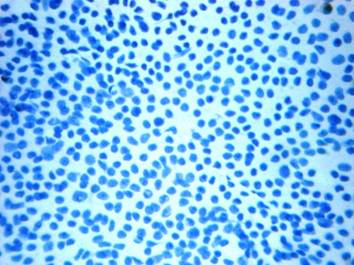An insight on pediatric peripheral Lymphadenopathy: Atwo year cytological study in a tertiary care hospital
Abstract
Introduction & Objective: Lymphadenopathy in pediatric population is an ever challenging situation. This study was done to study the cytological features of non-neoplastic and neoplastic lesions of enlarged lymph nodes by fine needle aspiration cytology (FNAC) and determine the pattern of diseases affecting the children below 18 years.
Materials and Methods: 453 cases between the age group of 0-18 years, referred to the cytology section of the department of Pathology were included in the study over a period of two years. Special stains and biopsy were done in selected cases.
Results: Majority of the cases were benign (97.60%), while only 2.4% (13/543 cases) of cases were malignant. Reactive hyperplasia, tuberculous lymphadenitis, suppurative lymphadenitis, metastatic carcinoma and lymphoma were seen in 53.2%, 30.20%, 10.68%, 0.2% and 1.8% respectively. Cervical group of lymph nodes were the most frequently affected nodes. In 37 cases, the cytological diagnosis was compared with histopathological diagnosis.
Conclusion: The most frequent cause for lymphadenopathy in pediatric population is reactive hyperplasia followed by tuberculosis. FNAC alone can be useful in establishing diagnosis in large number of cases in proper clinical setting and obviates the need for invasive procedures like surgery.
Downloads
References
2. Saboorian, M H, Ashfaq R. The use of fine needle aspiration biopsy in the evaluation of lymphadenopathy.SeminDiagnPathol. 2001 May;18(2):110-23. [PubMed]
3. Ingolfsdottir M, Balle V, Hahn CH. Evaluation of cervical lymphadenopathy in children: advantages and drawbacks of diagnostic methods.Dan Med J. 2013 Aug;60(8):A4667. [PubMed]
4. Gwili NM, Hadi MA, Eldin AN, Hassab HM, Eldin YS, Fadel SH, Mashali NA. Lymphadenopathy in a series of Egyptian pediatric patients and the role of pathology in the diagnostic workup.Pediatr Dev Pathol. 2014 Sep-Oct;17(5):344-59. doi:10.2350/14-03-1480-OA.1.
5. Wakely PE Jr. Merits of fine-needle aspiration biopsy in children; Head and neck. DiagnCytopathol. 1992;8(3):299-301. [PubMed]
6. Ponder TB, Smith D, RamzyI.Lymphadenopathy in children and adolescents: role of fine-needle aspiration in management. Cancer Detect Prev. 2000;24(3):228-33. [PubMed]
7. Khan RA, Wahab S, Chana RS, Naseem S, Siddique S. Children with significant cervical lymphadenopathy: Clinicopathological analysis and role of fine‑needle aspiration in Indian setup. J Pediatr (Rio J). 2008 Sep-Oct;84(5):449-54.doi:10.2223/JPED.1840.
8. van de Schoot L, Aronson DC, Behrendt H, Bras J. The role of fine‑needle aspiration cytology in children with persistent or suspicious lymphadenopathy.J Pediatr Surg. 2001 Jan;36(1):7-11. [PubMed]
9. Jain M, Majumdar DD, Agarwal K, Bais AS, Choudhury M.FNAC as a diagnostic tool in pediatric head and neck lesions.IndianPediatr. 1999 Sep;36(9):921-3. [PubMed]
10. Dey P, Mallik MK, Gupta SK, Vasishta RK. Role of fine needle aspiration cytology in the diagnosis of soft tissue tumours and tumour‑like lesions.Cytopathology. 2004 Feb;15(1):32-7. [PubMed]
11. Leung AK, Robson WL. Childhood cervical lymphadenopathy.J Pediatr Health Care. 2004 Jan-Feb;18(1):3-7. [PubMed]
12. Annam V, Kulkarni MH, Puranik RB. Clinicopatholog¬ic profile of significant cervical lymphadenopathy in children aged 1-12 years. ActaCytol. 2009 Mar-Apr;53(2):174-8. [PubMed]
13. el Hag IA, Chiedozi LC, al Reyees FA, Kollur SM. Fine needle aspiration cytology of head and neck masses. Seven years' experience in a secondary care hospital.ActaCytol. 2003 May-Jun;47(3):387-92. [PubMed]
14. Sarma PK, Chowhan AK, Agrawal V, Agarwal V. Fine needle aspiration cytology in HIV-related lymphadenopathy: experience at a single centre in north India. Cytopathology. 2010 Aug;21(4):234-9. doi: 10.1111/j.1365-2303.2009.00712.x. Epub 2009 Oct 15.
15. Bezabih M, Mariam DW, Selassie SG. Fine needle aspiration cytology of suspected tuberculous lymphadenitis.Cytopathology. 2002 Oct;13(5):284-90. [PubMed]
16. Wright CA, Warren RM, Marais BJ. Fine needle aspiration biopsy: an undervalued diagnostic modality in paediatric mycobacterial disease. Int J Tuberc Lung Dis. 2009 Dec;13(12):1467-75. [PubMed]
17. Lau SK,WeiWI,Kwan S, Yew WW.Combined use of fine-needle aspiration cytologic examination and tuberculin skin test in the diagnosis of cervical tuberculous lymphadenitis. A prospective study.Arch Otolaryngol Head Neck Surg. 1991 Jan;117(1):87-90.
18. IyerVK.Pediatric lymphoma diagnosis: role of FNAC, biopsy, immunohistochemistry and molecular diagnostics. Indian J Pediatr. 2013 Sep;80(9):756-63. doi: 10.1007/s12098-013-1128-2. Epub 2013 Aug 8.
19. Ahmad T, Naeem M, Ahmad S, Samad A, Nasir A.Fine needle aspiration cytology (FNAC) and neck swellings in the surgical outpatient. J Ayub Med Coll Abbottabad. 2008 Jul-Sep;20(3):30-2. [PubMed]
20. Steel BL, Schwartz MR, Ramzy I. Fine needle aspi¬ration biopsy in the diagnosis of lymphadenopathy in 1,103 patients. Role, limitations and analysis of diag¬nostic pitfalls.ActaCytol. 1995 Jan-Feb;39(1):76-81.
21. Lee DH, Baek HJ, Kook H, Yoon TM, Lee JK, Lim SC. Clinical value of fine needle aspiration cytology in pediatric cervical lymphadenopathy patients under 12-years-of-age. Int J PediatrOtorhinolaryngol. 2014 Jan;78(1):79-81. doi: 10.1016/j.ijporl.2013.10.054. Epub 2013 Nov 14.

Copyright (c) 2016 Author (s). Published by Siddharth Health Research and Social Welfare Society

This work is licensed under a Creative Commons Attribution 4.0 International License.


 OAI - Open Archives Initiative
OAI - Open Archives Initiative


